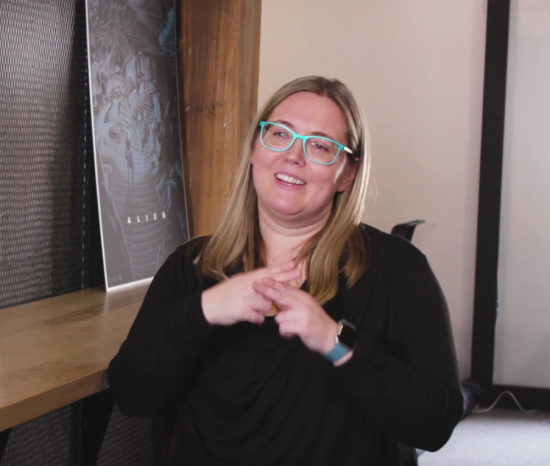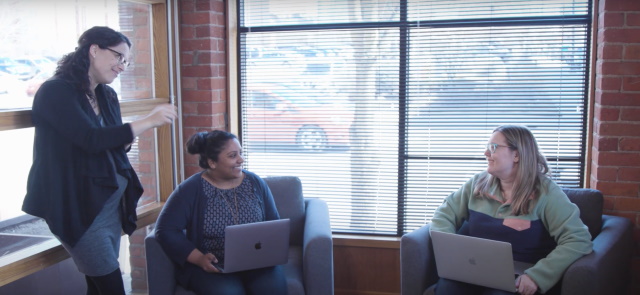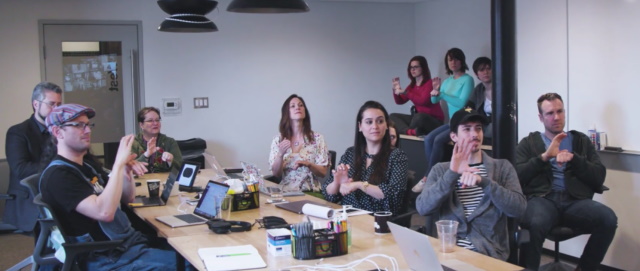2021-March-03
Did you know? You can share this story using the social media icons on the upper left. Use the hashtag #WeAreCisco. You can also rate or comment on the story below.
I’m Proud to Be Deaf
BY JULIE KRAMER · MARKETING COORDINATOR · UNITED STATES
WITH HELEN GALL
Joining an impromptu Cisco Webex call is one of the most common tasks for Cisconians. Anyone with a digital device can communicate seamlessly with colleagues at any time, wherever they are. It’s as simple as that.

Unless you’re deaf, like me.
The World Health Organization counts 466 million people in the world who are Deaf, Hard of Hearing, or have experienced hearing loss. That’s over five percent of the world's population. We each have a unique experience and story.
Some of us are profoundly Deaf and cannot hear anything. Others are Deaf or Hard of Hearing and wear hearing aids.
Some of us use sign language to communicate. Others read lips and use spoken language.
Some of us went to schools for the Deaf. Others attended public school.
I was born Profoundly Deaf and remain so to this day. In my life, I have never heard a single sound.
For me, there is only ever silence
I can compensate, to a point. I depend on my hands and eyes a lot, and my other senses are very sharp. Usually, I can feel when something is going on behind me, and I’ll turn around to see what it is. When people see this, they think that I heard them approach.
Actually, it’s my other senses that alerted me. I can sense the slightest vibration or see the faintest shadow in my peripheral vision.
I am proud to be Deaf
I’m the only one in my family who is Deaf. English is my second language, after American Sign Language (ASL). (Fun fact: There are somewhere between 138 and 300 different types of sign language used around the globe today. Most countries that share the same spoken language may not have the same sign language.)
Growing up, I attended public school, where I split my learning time between a dedicated Deaf program and hearing classrooms.
In my Deaf program, we had a teacher who communicated in ASL. In my hearing classrooms, I had a translator with me and learned right alongside all of the other students. Essentially, I was taking classes in two separate languages!
After graduation, I went to the National Technical Institute for the Deaf at Rochester Institute of Technology in Rochester, New York, where I was one of over 1,100 Deaf and Hard of Hearing students. I transferred to Barton College in Wilson, North Carolina, where I was the only Deaf student. The distinction could not have been greater, and the diverse experiences more rewarding.
Professional support
Both college experiences prepared me exceptionally well for my career. I began working in the marketing department for Duo Security in 2014, where the company created a fully accessible environment for me.
For structured gatherings like meetings, events, and conferences, I’m provided an interpreter.
For more informal and spontaneous communications — like daily interactions with my fellow employees — I can use an interpreter if one is available.
If the interpreter isn’t around, I use non-verbal methods and support tools, like instant messaging, written notes, text messages, or, depending on the circumstance, a video relay interpreter.
(A video relay interpreter communicates between myself and who I’m calling on the phone. It’s like a regular phone call, but the interpreter speaks for me and lets me know what you say.)

In most cases, I prefer to have an interpreter and attend live meetings and events. It helps me feel more connected with my colleagues. And while there are processes in place for procuring an interpreter, the process is challenging, as the available pool is limited to begin with. It gets even smaller when I need one skilled in conversing in high-tech verbiage.
My situation is not the standard, however. In many cases, Deaf individuals don’t have access to the needed communication tools. So their communication opportunities, both at work and home, might be far more limited.
Their workplace might also not be as supportive as mine. Last year, with the Duo team’s help, I co-hosted a National Deaf Awareness Month event called Learn ASL Together With Us.
I invited and introduced two Deaf organizations, the Michigan Deaf Association and National Black Deaf Advocates. They offered information about their organizations, and I shared insights about Deaf history and culture while teaching ASL to attendees.
In my shoes
If you want to know what being deaf feels like, you can put on headphones, plug your ears when you join a meeting, or try to communicate without voice or noise. That’s, of course, an attempt to simulate the physical act of living without hearing.
But being deaf affects far more than the physical. There are ongoing challenges wherever I go, which affect me emotionally and mentally. (Try reading lips these past 10 months when everyone has worn face masks!)

But these setbacks are balanced — to an extent — by the overwhelming support I receive at work and at home, where colleagues, friends, and family demonstrate care, respect, and inclusivity.
Some employees even ask me to teach them ASL since they want to communicate with me in my native language. And for those who don’t, it’s not that they’re uncaring or unsupportive. Usually, they just haven’t met me or others like me.
Which brings me to my important request: The next time you begin a Webex meeting, start the call with closed captions using Webex Assistant, please. Some of us are Deaf or Hard of Hearing. And, at Cisco, we each have the opportunity to communicate at our fingertips.
Related Links
Connect everything. Innovate everywhere. Benefit everyone.
Share your thoughts!
Log in to rate and commentShare your thoughts on the story here!